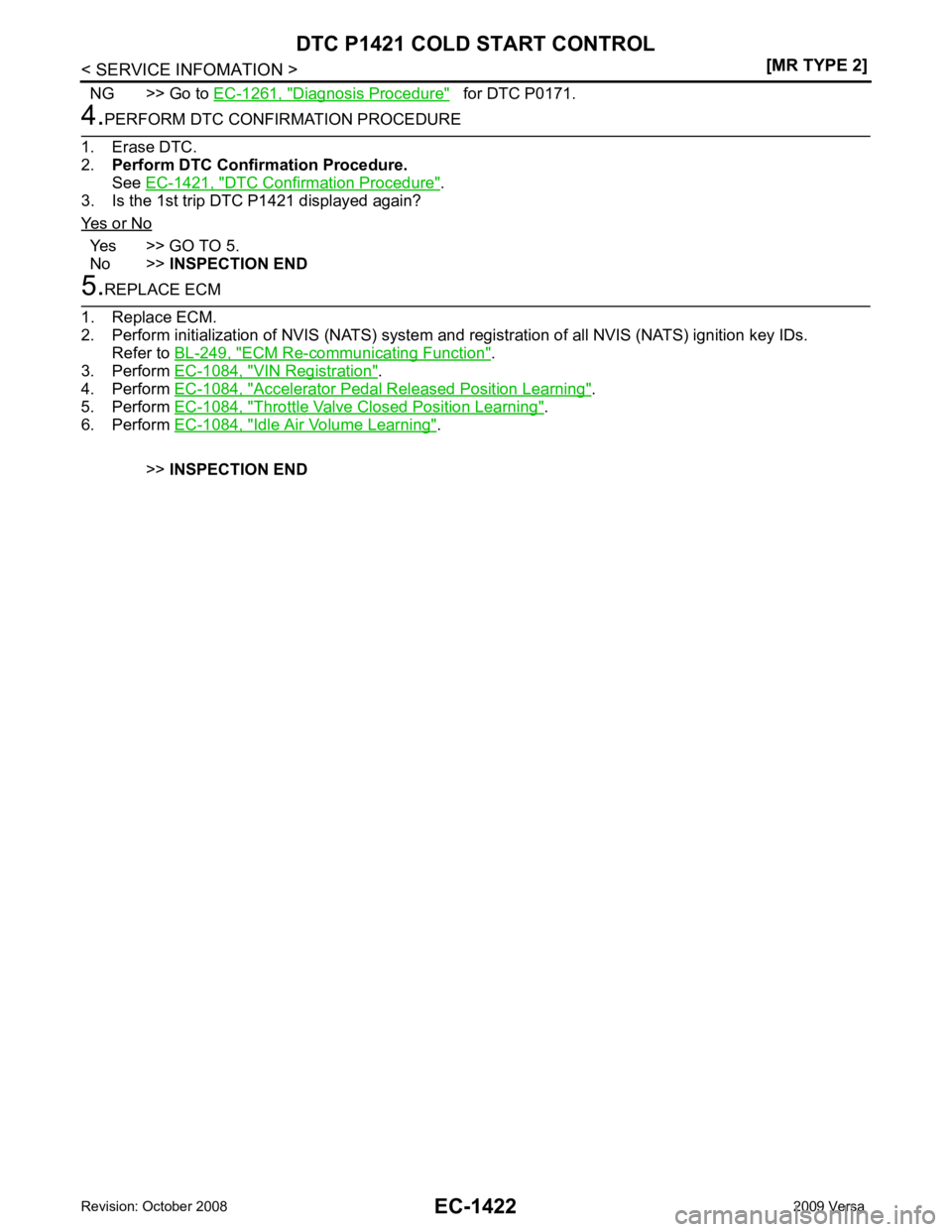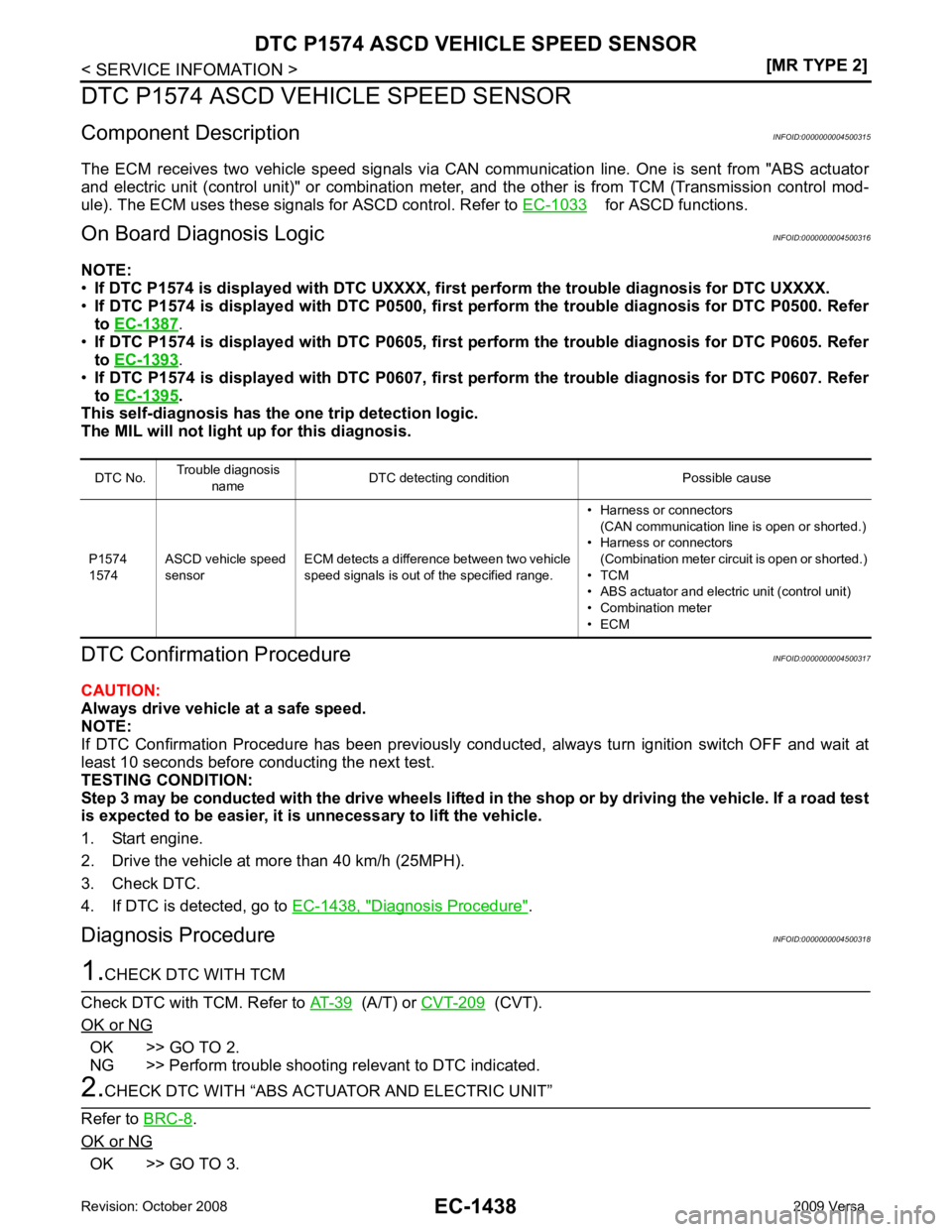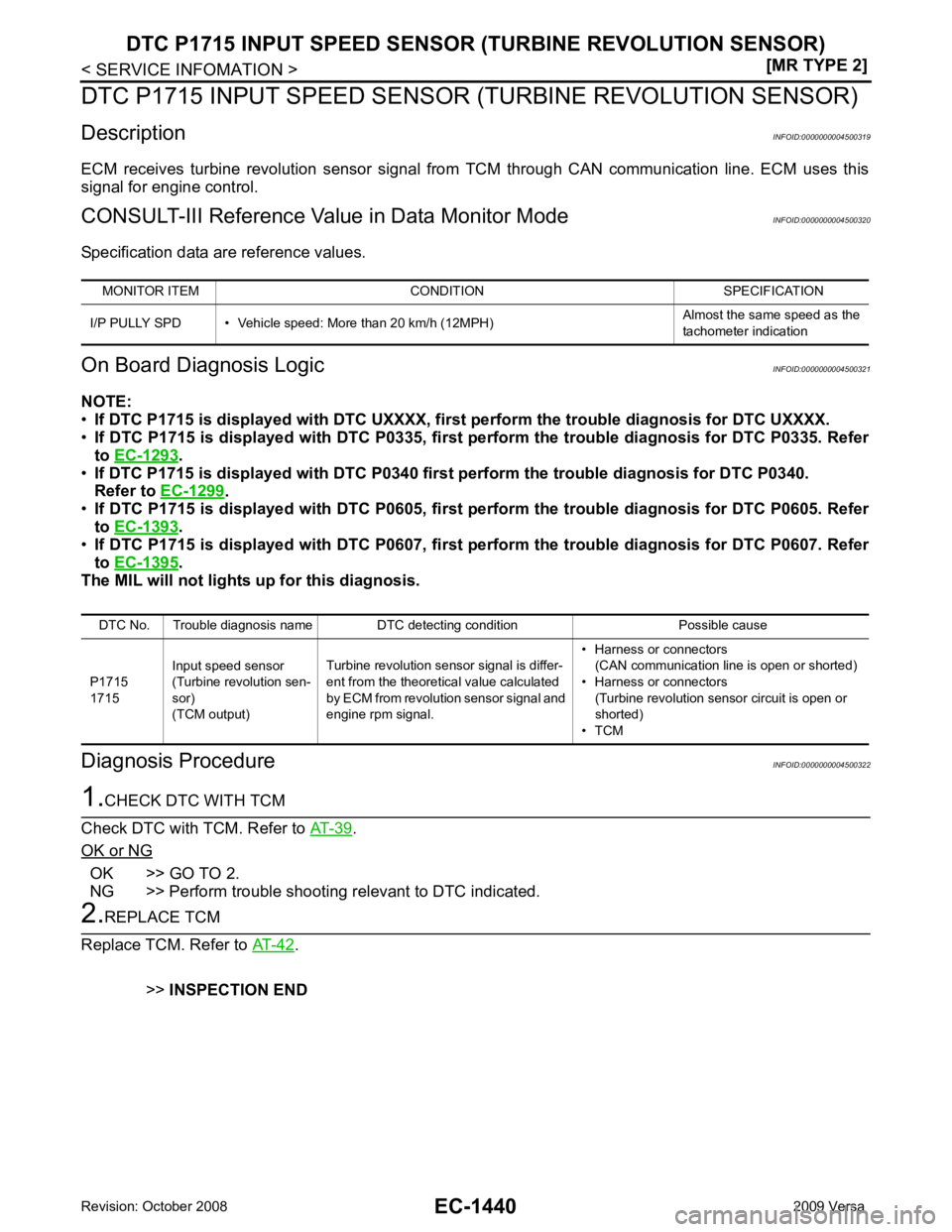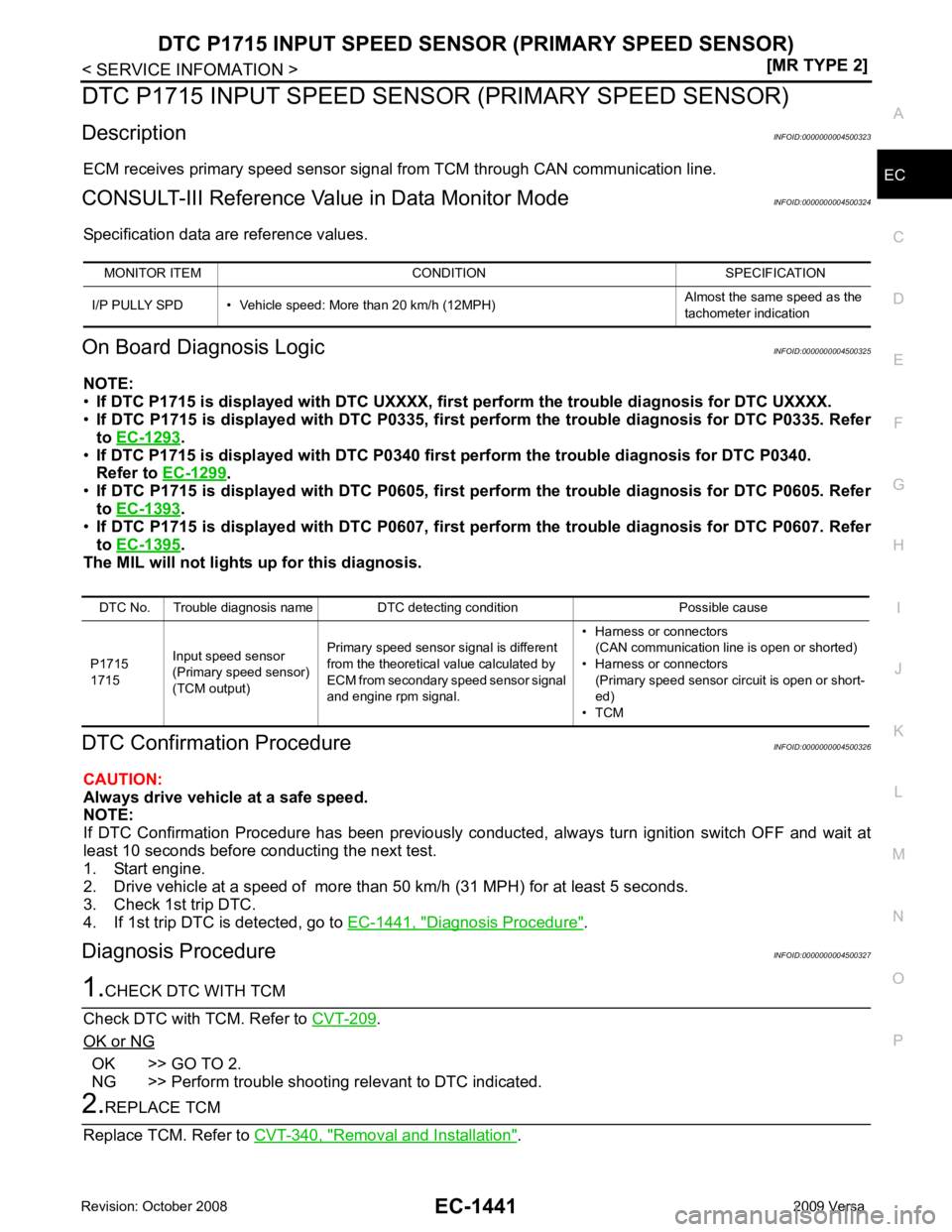2009 NISSAN LATIO display
[x] Cancel search: displayPage 2778 of 4331

Diagnosis Procedure " for DTC P0171.
DTC Confirmation Procedure " .
3. Is the 1st trip DTC P1421 displayed again?
Yes or No Yes >> GO TO 5.
No >> INSPECTION END ECM Re-communicating Function " .
3. Perform EC-1084, " VIN Registration " .
4. Perform EC-1084, " Accelerator Pedal Released Position Learning " .
5. Perform EC-1084, " Throttle Valve Closed Position Learning " .
6. Perform EC-1084, " Idle Air Volume Learning " .
>> INSPECTION END
Page 2779 of 4331
![NISSAN LATIO 2009 Service Repair Manual DTC P1564 ASCD STEERING SWITCH
EC-1423
< SERVICE INFOMATION >
[MR TYPE 2] C
D E
F
G H
I
J
K L
M A EC
NP
O
DTC P1564 ASCD STEERING SWITCH
Component Description INFOID:0000000004500301
ASCD steering swi NISSAN LATIO 2009 Service Repair Manual DTC P1564 ASCD STEERING SWITCH
EC-1423
< SERVICE INFOMATION >
[MR TYPE 2] C
D E
F
G H
I
J
K L
M A EC
NP
O
DTC P1564 ASCD STEERING SWITCH
Component Description INFOID:0000000004500301
ASCD steering swi](/manual-img/5/57359/w960_57359-2778.png)
DTC P1564 ASCD STEERING SWITCH
EC-1423
< SERVICE INFOMATION >
[MR TYPE 2] C
D E
F
G H
I
J
K L
M A EC
NP
O
DTC P1564 ASCD STEERING SWITCH
Component Description INFOID:0000000004500301
ASCD steering switch has variant values of electrical resistance for each button. ECM reads voltage variation
of switch, and determines which button is operated.
Refer to EC-1033 for the ASCD function.
CONSULT-III Reference Val ue in Data Monitor Mode INFOID:0000000004500302
Specification data are reference values.
On Board Diagnosis Logic INFOID:0000000004500303
This self-diagnosis has the on e trip detection logic.
The MIL will not light up for this diagnosis.
NOTE:
If DTC P1564 is displayed with DTC P0605, first perform the trouble diagnosis for DTC P0605.
Refer to EC-1393 .
1. ASCD steering switch 2. MAIN switch 3. CANCEL switch
4. RESUME/ACCELERATE switch 5. SET/COAST switch BBIA0707E
MONITOR ITEM CONDITION SPECIFICATION
MAIN SW • Ignition switch: ON MAIN switch: Pressed ON
MAIN switch: Released OFF
CANCEL SW • Ignition switch: ON CANCEL switch: Pressed ON
CANCEL switch: Released OFF
RESUME/ACC SW • Ignition switch: ON RESUME/ACCELERATE switch:
Pressed ON
RESUME/ACCELERATE switch: Re-
leased OFF
SET SW • Ignition switch: ON SET/COAST switch: Pressed ON
SET/COAST switch: Released OFF DTC No.
Trouble diagnosis
name DTC detecting condition Possible cause
P1564
1564 ASCD steering switch • An excessively high voltage signal from the
ASCD steering switch is sent to ECM.
• ECM detects that input signal from the
ASCD steering switch is out of the specified
range.
• ECM detects that the ASCD steering switch
is stuck ON. • Harness or connectors
(ASCD switch circuit is open or shorted.)
• ASCD steering switch
• ECM
Page 2785 of 4331
![NISSAN LATIO 2009 Service Repair Manual DTC P1572 ASCD BRAKE SWITCH
EC-1429
< SERVICE INFOMATION >
[MR TYPE 2] C
D E
F
G H
I
J
K L
M A EC
NP
O
DTC P1572 ASCD BRAKE SWITCH
Component Description INFOID:0000000004500308
When the brake pedal NISSAN LATIO 2009 Service Repair Manual DTC P1572 ASCD BRAKE SWITCH
EC-1429
< SERVICE INFOMATION >
[MR TYPE 2] C
D E
F
G H
I
J
K L
M A EC
NP
O
DTC P1572 ASCD BRAKE SWITCH
Component Description INFOID:0000000004500308
When the brake pedal](/manual-img/5/57359/w960_57359-2784.png)
DTC P1572 ASCD BRAKE SWITCH
EC-1429
< SERVICE INFOMATION >
[MR TYPE 2] C
D E
F
G H
I
J
K L
M A EC
NP
O
DTC P1572 ASCD BRAKE SWITCH
Component Description INFOID:0000000004500308
When the brake pedal is depressed, ASCD brake switch (2) is
turned OFF and stop lamp switch (1) is turned ON. ECM detects the
state of the brake pedal by this input of two kinds (ON/OFF signal).
Refer to EC-1033 for the ASCD function.
CONSULT-III Reference Val ue in Data Monitor Mode INFOID:0000000004500309
Specification data are reference values.
On Board Diagnosis Logic INFOID:0000000004500310
This self-diagnosis has the on e trip detection logic.
The MIL will not light up for this diagnosis.
NOTE:
• If DTC P1572 is displayed with DT C P0605, first perform the trouble diagnosis for DTC P0605. Refer
to EC-1393 .
• This self-diagnosis has the one trip detection logic. When malfunction A is detected, DTC is not
stored in ECM memory. And in that case, 1st trip DTC and 1st trip freeze frame data are displayed.
1st trip DTC is erased when igniti on switch OFF. And even when ma lfunction A is detected in two
consecutive trips, DTC is not stored in ECM memory. BBIA0708E
MONITOR ITEM CONDITION SPECIFICATION
BRAKE SW1
(ASCD brake switch) • Ignition switch: ON• Brake pedal: Fully released (A/T, CVT)
• Brake pedal and clutch pedal: Fully re- leased (M/T) ON
• Brake pedal: Slightly depressed (A/T, CVT)
• Brake pedal and/or clutch pedal: Slight- ly depressed (M/T) OFF
BRAKE SW2
(Stop lamp switch) • Ignition switch: ONBrake pedal: Fully released OFF
Brake pedal: Slightly depressed ON DTC No.
Trouble diagnosis
name DTC detecting condition Possible cause
P1572
1572 ASCD brake switch A)
When the vehicle speed is above 30km/h (19
MPH), ON signals from the stop lamp switch
and the ASCD brake switch are sent to ECM
at the same time. • Harness or connectors
(Stop lamp switch circuit is shorted.)
• Harness or connectors (ASCD brake switch circuit is shorted.)
• Harness or connectors
(ASCD clutch switch circuit is shorted.)
(M/T)
• Stop lamp switch
• ASCD brake switch
• ASCD clutch switch (M/T)
• Incorrect stop lamp switch installation
• Incorrect ASCD brake switch installation
• Incorrect ASCD clutch switch installation (M/T)
• ECM
B)
ASCD brake switch signal is not sent to ECM
for extremely long time while the vehicle is
driving
Page 2794 of 4331

for ASCD functions.
On Board Diagn osis Logic INFOID:0000000004500316
NOTE:
• If DTC P1574 is displayed with DTC UXXXX, first perform the tr ouble diagnosis for DTC UXXXX.
• If DTC P1574 is displayed with DTC P0500, first pe rform the trouble diagnosis for DTC P0500. Refer
to EC-1387 .
This self-diagnosis has the one trip detection logic.
The MIL will not light up for this diagnosis.
DTC Confirmation Procedure INFOID:0000000004500317
CAUTION:
Always drive vehicle at a safe speed.
NOTE:
If DTC Confirmation Procedure has been previously conduc ted, always turn ignition switch OFF and wait at
least 10 seconds before conducting the next test.
TESTING CONDITION:
Step 3 may be conducted with the drive wheels lifted in the shop or by driving the vehicle. If a road test
is expected to be easier, it is unnecessary to lift the vehicle.
1. Start engine.
2. Drive the vehicle at more than 40 km/h (25MPH).
3. Check DTC.
4. If DTC is detected, go to EC-1438, " Diagnosis Procedure " .
Diagnosis Procedure INFOID:0000000004500318 (A/T) or
CVT-209 (CVT).
OK or NG OK >> GO TO 2.
NG >> Perform trouble shooting relevant to DTC indicated. .
OK or NG OK >> GO TO 3.DTC No.
Trouble diagnosis
name DTC detecting condition Possible cause
P1574
1574 ASCD vehicle speed
sensor ECM detects a difference between two vehicle
speed signals is out of the specified range. • Harness or connectors
(CAN communication line is open or shorted.)
• Harness or connectors (Combination meter circuit is open or shorted.)
• TCM
• ABS actuator and electric unit (control unit)
• Combination meter
• ECM
Page 2796 of 4331

.
• If DTC P1715 is displayed with DTC P0340 first perform the trouble diagnosis for DTC P0340.
Refer to EC-1299 .
• If DTC P1715 is displayed with DTC P0605, first pe rform the trouble diagnosis for DTC P0605. Refer
to EC-1393 .
• If DTC P1715 is displayed with DTC P0607, first pe rform the trouble diagnosis for DTC P0607. Refer
to EC-1395 .
The MIL will not lights up for this diagnosis.
Diagnosis Procedure INFOID:0000000004500322.
OK or NG OK >> GO TO 2.
NG >> Perform trouble shooting relevant to DTC indicated. .
>> INSPECTION END
MONITOR ITEM CONDITION SPECIFICATION
I/P PULLY SPD • Vehicle speed: More than 20 km/h (12MPH) Almost the same speed as the
tachometer indication DTC No. Trouble diagnosis name DTC detecting condition Possible cause
P1715
1715 Input speed sensor
(Turbine revolution sen-
sor)
(TCM output) Turbine revolution sensor signal is differ-
ent from the theoretical value calculated
by ECM from revolution sensor signal and
engine rpm signal. • Harness or connectors
(CAN communication line is open or shorted)
• Harness or connectors (Turbine revolution sensor circuit is open or
shorted)
• TCM
Page 2797 of 4331

EC
NP
O
DTC P1715 INPUT SPEED SENS
OR (PRIMARY SPEED SENSOR)
Description INFOID:0000000004500323
ECM receives primary speed sensor signal from TCM through CAN communication line.
CONSULT-III Reference Val ue in Data Monitor Mode INFOID:0000000004500324
Specification data are reference values.
On Board Diagnosis Logic INFOID:0000000004500325
NOTE:
• If DTC P1715 is displayed with DTC UXXXX, first perform the tr ouble diagnosis for DTC UXXXX.
• If DTC P1715 is displayed with DT C P0335, first perform the trouble diagnosis for DTC P0335. Refer
to EC-1293 .
• If DTC P1715 is displayed with DTC P0340 firs t perform the trouble diagnosis for DTC P0340.
Refer to EC-1299 .
• If DTC P1715 is displayed with DT C P0605, first perform the trouble diagnosis for DTC P0605. Refer
to EC-1393 .
• If DTC P1715 is displayed with DT C P0607, first perform the trouble diagnosis for DTC P0607. Refer
to EC-1395 .
The MIL will not lights up for this diagnosis.
DTC Confirmation Procedure INFOID:0000000004500326
CAUTION:
Always drive vehicle at a safe speed.
NOTE:
If DTC Confirmation Procedure has been previously conduc ted, always turn ignition switch OFF and wait at
least 10 seconds before conducting the next test.
1. Start engine.
2. Drive vehicle at a speed of more than 50 km/h (31 MPH) for at least 5 seconds.
3. Check 1st trip DTC.
4. If 1st trip DTC is detected, go to EC-1441, " Diagnosis Procedure " .
Diagnosis Procedure INFOID:0000000004500327.
OK or NG OK >> GO TO 2.
NG >> Perform trouble shooting relevant to DTC indicated. Removal and Installation " .
MONITOR ITEM CONDITION SPECIFICATION
I/P PULLY SPD • Vehicle speed: More than 20 km/h (12MPH) Almost the same speed as the
tachometer indication DTC No. Trouble diagnosis name DTC detecting condition Possible cause
P1715
1715 Input speed sensor
(Primary speed sensor)
(TCM output) Primary speed sensor signal is different
from the theoretical value calculated by
ECM from secondary speed sensor signal
and engine rpm signal. • Harness or connectors
(CAN communication line is open or shorted)
• Harness or connectors (Primary speed sensor circuit is open or short-
ed)
• TCM
Page 2807 of 4331

EC
NP
O
DTC P2101 ELECTRIC THRO
TTLE CONTROL FUNCTION
Description INFOID:0000000004500341
NOTE:
If DTC P2101 is displayed with DTC P2100 or P2119, first perform the trouble diagnosis for DTC P2100
or P2119. Refer to EC-1447 or
EC-1462 .
Electric throttle control actuator consists of throttle control motor, throttle position sensor, etc.
The throttle control motor is operated by the ECM and it opens and closes the throttle valve.
The current opening angle of the throttle valve is detected by the throttle position sensor and it provides feed-
back to the ECM to control the throttle control motor to make the throttle valve opening angle properly in
response to driving condition.
On Board Diagnosis Logic INFOID:0000000004500342
This self-diagnosis has the on e trip detection logic.
FAIL-SAFE MODE When the malfunction is detec ted, the ECM enters fail-safe mode and the MIL lights up.
DTC Confirmation Procedure INFOID:0000000004500343
NOTE:
If DTC Confirmation Procedure has been previously conduc ted, always turn ignition switch OFF and wait at
least 10 seconds before conducting the next test.
TESTING CONDITION:
Before performing the follo wing procedure, confirm that battery vo ltage is more than 11V when engine
is running.
1. Turn ignition switch ON and wait at least 2 seconds.
2. Start engine and let it idle for 5 seconds.
3. Check DTC.
4. If DTC is detected, go to EC-1453, " Diagnosis Procedure " .
DTC No. Trouble diagnosis name DTC detecting condition Possible cause
P2101
2101 Electric throttle control
performance Electric throttle control function does not oper-
ate properly. • Harness or connectors
(Throttle control motor circuit is open or
shorted)
• Electric throttle control actuator Engine operating condition in fail-safe mode
ECM stops the electric throttle control actuator control, throttle valve is maintained at a fixed opening (approx. 5 degrees) b y the return
spring.
Page 2820 of 4331
![NISSAN LATIO 2009 Service Repair Manual EC-1464< SERVICE INFOMATION >
[MR TYPE 2]
DTC P2122, P2123 APP SENSOR
DTC P2122, P2123 APP SENSOR
Component Description INFOID:0000000004500359
The accelerator pedal position sensor is installed NISSAN LATIO 2009 Service Repair Manual EC-1464< SERVICE INFOMATION >
[MR TYPE 2]
DTC P2122, P2123 APP SENSOR
DTC P2122, P2123 APP SENSOR
Component Description INFOID:0000000004500359
The accelerator pedal position sensor is installed](/manual-img/5/57359/w960_57359-2819.png)
EC-1464< SERVICE INFOMATION >
[MR TYPE 2]
DTC P2122, P2123 APP SENSOR
DTC P2122, P2123 APP SENSOR
Component Description INFOID:0000000004500359
The accelerator pedal position sensor is installed on the upper end
of the accelerator pedal assembly. The sensor detects the accelera-
tor position and sends a signal to the ECM.
Accelerator pedal position sensor has two sensors. These sensors
are a kind of potentiometers which transform the accelerator pedal
position into output voltage, and emit the voltage signal to the ECM.
In addition, these sensors detect the opening and closing speed of
the accelerator pedal and feed the voltage signals to the ECM. The
ECM judges the current opening angle of the accelerator pedal from
these signals and controls the throttle control motor based on these
signals.
Idle position of the accelerator pedal is determined by the ECM
receiving the signal from the accelerator pedal positi on sensor. The ECM uses this signal for the engine oper-
ation such as fuel cut.
CONSULT-III Reference Value in Data Monitor Mode INFOID:0000000004500360
Specification data are reference values.
*: Accelerator pedal position sensor 2 signal is converted by ECM internally. Thus, it differs from ECM terminal voltage.
On Board Diagn osis Logic INFOID:0000000004500361
These self-diagnoses have the one trip detection logic.
NOTE:
If DTC P2122 or P2123 is displayed with DTC P0643, first perform the trouble diagnosis for DTC P0643.
Refer to EC-1396 .
FAIL-SAFE MODE
When the malfunction is detected, ECM enters fail-safe mode and the MIL lights up.
DTC Confirmation Procedure INFOID:0000000004500362
NOTE: PBIB1741E
MONITOR ITEM CONDITION SPECIFICATION
ACCEL SEN 1 • Ignition switch: ON
(Engine stopped) Accelerator pedal: Fully released 0.6 - 0.9V
Accelerator pedal: Fully depressed 4.0 - 4.8V
ACCEL SEN 2* • Ignition switch: ON
(Engine stopped) Accelerator pedal: Fully released 0.6 - 0.9V
Accelerator pedal: Fully depressed 3.9 - 4.8V
CLSD THL POS • Ignition switch: ON
(Engine stopped) Accelerator pedal:
Fully released ON
Accelerator pedal: Slightly depressed OFF DTC No. Trouble diagnosis name DTC detecting condition Possible cause
P2122
2122 Accelerator pedal position
sensor 1 circuit low input An excessively low
voltage from the APP
sensor 1 is sent to ECM. • Harness or connectors
(APP sensor 1 circuit is open or shorted.)
• Accelerator pedal position sensor (APP sensor 1)
P2123
2123 Accelerator pedal position
sensor 1 circuit high input An excessively high voltage from the APP
sensor 1 is sent to ECM. Engine operating condition in fail-safe mode
The ECM controls the electric throttle control actuator in regulating the throttle opening in order for the idle position to be within +10
degrees.
The ECM regulates the opening speed of the throttle valve to be slower than the normal condition.
So, the acceleration will be poor.